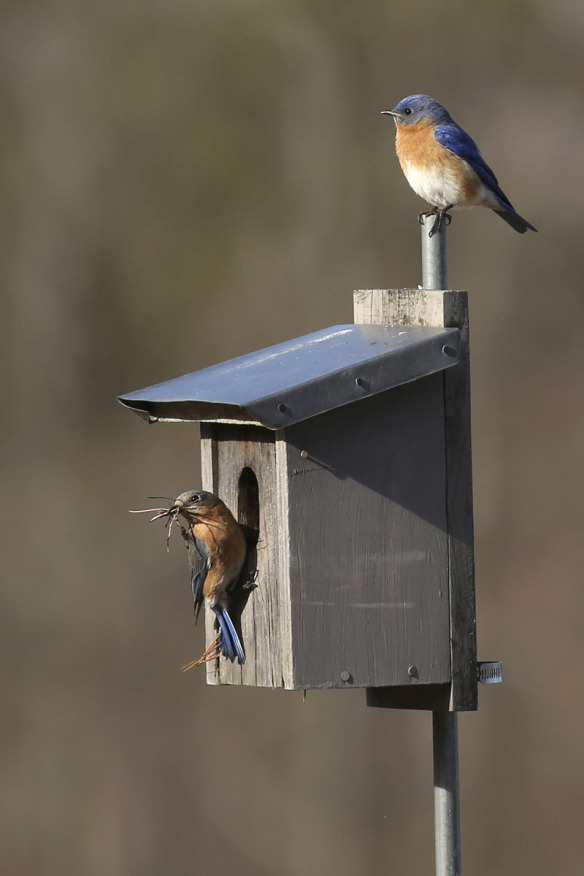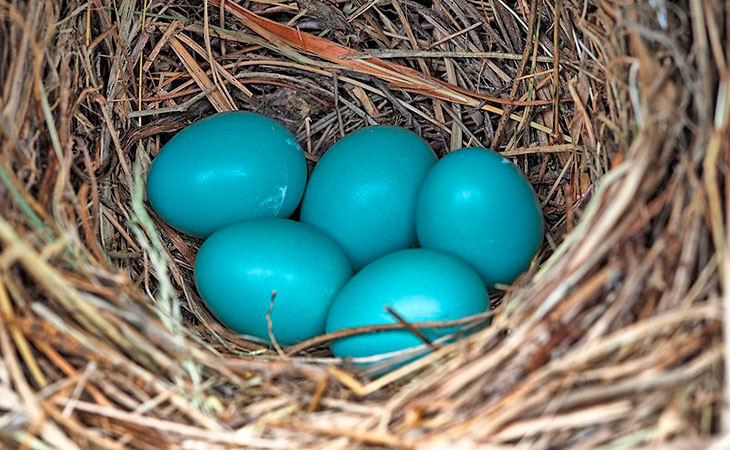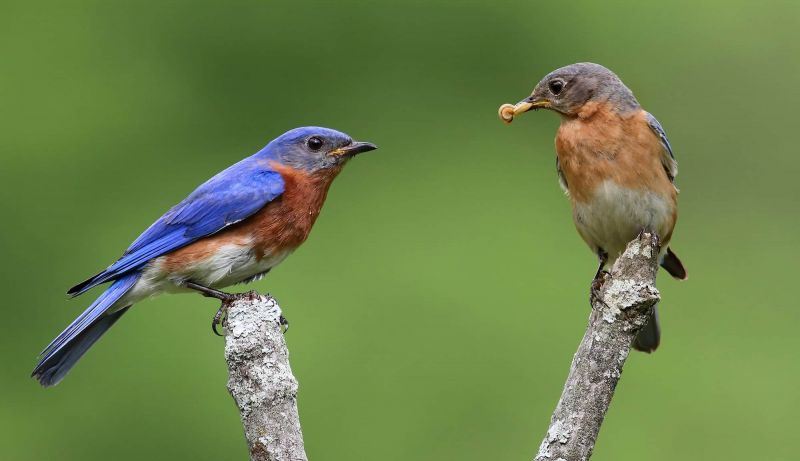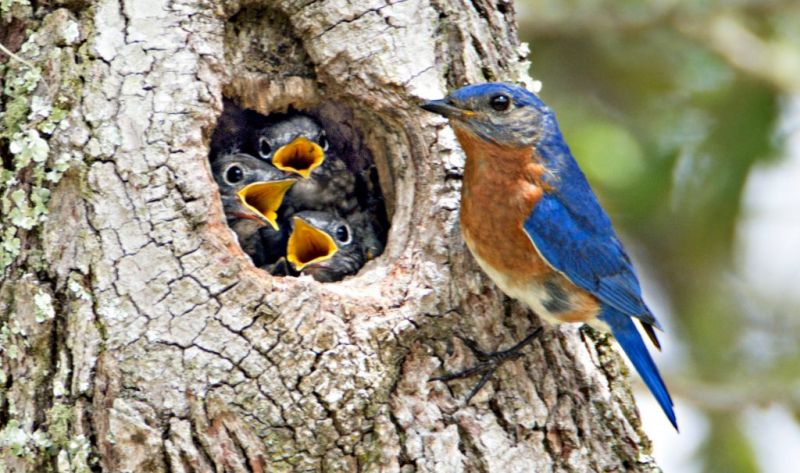Due to the loss of nesting sites and habitats, eastern bluebirds were once an endangered species. Bluebirds faced stiff competition for nesting sites from starlings and house sparrows, which raised concern over their survival. However, due to the establishment of various birding groups and people setting up birdhouses across the country, eastern bluebirds are coming back again, and this time, they’re increasing more than ever. While it might come as a surprise, it’s important to note that eastern bluebirds were just as common as the American Robin, making it all exciting to witness their comeback. Most eastern bluebirds measure about 6.5 inches in length while also weighing up to 30g. A bluebird nest tends to vary between 5″ x 6″ in size.
The male eastern bluebirds are often characterized by having a reddish breast area, blue feathers for the upper part body, and a mostly white belly.
On the other hand, the female eastern bluebird have a grayish-blue head, a buffy throat and breast area and mostly down light blue tails and wings. If you’re looking to spot eastern bluebirds, you’ll likely find them in rural gardens, suburban gardens, open farmlands, and rural gardens.
Arguably one of the fascinating birds to watch and keep out there, eastern bluebirds have interesting nesting habits. There are many practices that make this species stand out from the rest.
Below is a breakdown of some of the most common nesting habits among and way of life among eastern bluebirds;

Nesting habits
If you’ve ever had a dream or the plan to start bird keeping, eastern bluebirds are the best candidates for this. The fact that eastern bluebirds are cavity nesters makes them the ideal species to keep in a birdhouse.
And based on how these birds have been on the verge of extinction before, you might want to begin on that plan right away. A bluebird nest is mostly made of plant stems, grasses, and pine needles, lined with feathers, soft grass, and in some cases with animal hair.
Their nests are often placed in a cavity, abandoned woodpecker hole, or a birdhouse. These nests are placed as low as 20 inches above the ground or as high as 50 inches above the ground. It’s important to note that most of the bluebird nest cavities are made by females.
However, if you plan to put your eastern bluebirds in a birdhouse, you should place it on a pole about 5-6 feet above the ground. This allows for much clearer monitoring and protection. You want to ensure that you can spot all the house sparrows that could endanger the eastern bluebirds.
Also, when hoisting the birdhouse for the eastern bluebirds, you want to ensure that the bluebird nest proper predator guards installed and that it faces away from prevailing winds.
The best way to keep the predators at bay is to ensure that you remove the nest regularly, use baffles among other guards on the nest poles. If you’re not handy enough with a nesting box, it’s better to get a birdhouse that is ideal for monitoring.
These birdhouses are often built with a clearer side and have in-built cameras for monitoring. Eastern bluebirds are known to begin their nesting around February- April if it is their first nesting. However, this might happen a bit later in the year for the multiple nesters and first-time nesters.

How many eggs do eastern bluebirds lay?
Eastern bluebirds often lay an egg every day until the clutch reaches 3-6 eggs that are pale blue or occasionally white in color. The female eastern bluebird is likely to begin the incubation process when they lay the last or next to the last egg.
Sometimes the female eastern bluebird might even wait for a day or two after the last egg is laid to start incubation. The incubation is often done by the female eastern bluebird and can take 13 to 16 days.
While these birds might start sitting on their eggs as soon as the first egg is laid, full-time incubation doesn’t begin until the last of the eggs is laid. The delay in the incubation process among the eastern bluebirds is a result of the prevailing weather conditions.
If the weather is warmer, they’re bound to begin incubation right away. However, the birds tend to delay the process during the winter. It’s also important to note that hatching among eastern bluebirds fails the most during the weather is warm.

Mating rituals and tidbits among eastern bluebirds
Eastern bluebirds, like many songbirds, display very unusual mating habits. Eastern bluebirds are widely regarded as one of the North American bird species that are socially monogamous but genetically polygynous and polyandrous.
Although there have been previous studies by different scientists naming eastern bluebirds as monogamous birds, this is no longer the case. Recent studies have shown that these birds no longer stick to one mating partner.
The female eastern bluebirds are widely considered socially monogamous and capable of mating with more than one male partner. It’s not unusual for the female eastern bluebirds to end up having several broods from different mating partners.
Interestingly, scientists have learned that the idea of female eastern bluebirds mating with different male partners is a good thing. This is because the broods sired from different male eastern bluebirds are usually healthier and stringer, thus guaranteeing a bigger probability of survival.
Further research has shown that female eastern bluebirds tend to multiply their mating partners. This explains why 30% to 60% of the eastern bluebirds’ nests contain young ones from more than one male mate.
Also, male eastern bluebirds usually have more than one nest, which translates to more than one mating partner. For this reason, the eggs found in the nests of eastern bluebirds do not necessarily come from a particular father.
The reason for the female eastern bluebirds multiplying their male mates is attributed to different reasons. One of the main reasons being that the female eastern bluebirds never get the chance of seeing all the available male mates before making a pick.
For this reason, whenever a better male mate comes along, the female eastern bluebird is bound to pick them. Another reason attributed to the female bluebirds multiplying male partners is that the one they pick might not have the best territory or site to build a nest.
Also, some studies have shown that a female eater bluebird is bound to multiply their male partners until they get one responsible for taking care of the young ones. For the male eastern bluebirds with no suitable site or territory, their options are very clear.
They either share a female with another male bird, challenge a male eastern bluebird for their territory or find a female mate in a female whose partner is dead or away. The female eastern bluebirds are likely to sire at least two broods in a given breeding season.

Feeding habits among the eastern bluebirds
Eastern bluebirds are known to feed on insects mostly. Research shows that 80% of these birds’ diet is made up of insects in both spring and summer. Bluebirds feed on a wide range of insects, including beetles, crickets, and grasshoppers, among many others.
On top of these insects, it’s also common to find these birds feeding on snails, smaller lizards, spiders, tree frogs, and earthworms. On top of these insects, eastern bluebirds also tend to feed on berries and fruits from small trees and shrubs, especially during the winter.
If you’re keeping eastern bluebirds at your home, you might want to try feeding them dried fruits or chopped peanut kernels. However, the best way to lure these birds into your bluebird nest is by offering them mealworms because they are known to love them.
If you’re trying to keep the eastern bluebirds around, offering them live or dried mealworms through a specially designed feeder is a great idea. This ensures that other bird species do not feed on them before they do.
For the mealworms, you can find them online, grow them at home or at your local pet supply store. However, do not consider feeding these birds birdseeds because they rarely eat that. It’s also important to note that eastern bluebirds are attracted to birdbaths more so those that involve running water with lots of splashing noises.
How do the eastern bluebirds feed the young ones?
When it comes to feeding the young ones, this is usually a family affair for the eastern bluebird. This is because both the male and female take part in feeding the hatchlings. Also, it’s not unusual to spot fledglings from a previous nest feeding the newly hatched young ones.
If the female eastern bluebird goes off to build a new nest, the male mate will remain behind and keep feeding the fledglings until the female comes back.
During this period, the male eastern bluebird teaches the young ones how to find food and protect themselves from impending predators. The young fledglings tend to leave the nest after about 18-19 days on average. Also, it’s very common for the adult eastern bluebirds to chase away the fledglings when there is another clutch that needs to be incubated.
Conclusion
Keeping eastern bluebirds in your birdhouse is a big responsibility that comes with lots of challenges. This is because you have to be a bit more involved compared to other birds out there. You’ll need to look out for predators more often and clean their nests frequently.
This is because eastern bluebirds are very keen on keeping their nest boxes clean. However, the best thing about keeping eastern bluebirds is that the reward is even bigger.
With eastern bluebirds perching on your birdfeeders, you get the most beautiful and colorful birds you can get. It’s also worth mentioning that you will fill your home with beautiful sounds from these birds.
Related
- Interested in more birds’ nesting habits? Check out The Pigeon Nest: Pigeon Nesting Habits And Behaviors and learn a little more about the nests of one of the more popular birds in the United States.
- Stumbled on a nest with chicks that seem hungry and you’re not sure what to do? Proceed with caution, and take a look at our article: What Do Baby Birds Eat? It’s important that you let mama bird feed her chicks, but if mom has not been seen in a long while you may have a few options available.
References
1. https://www.wild-bird-watching.com/Blue_Birds.html
2. https://www.audubon.org/field-guide/bird/eastern-bluebird
3. http://www.birdhouses101.com/Eastern-Bluebird-mating.asp
Leave a Reply